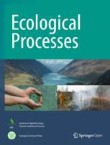Ver ítem
- xmlui.general.dspace_homeCentros Regionales y EEAsCentro Regional Patagonia SurEEA Santa CruzArtículos científicosxmlui.ArtifactBrowser.ItemViewer.trail
- Inicio
- Centros Regionales y EEAs
- Centro Regional Patagonia Sur
- EEA Santa Cruz
- Artículos científicos
- Ver ítem
Carbon pool dynamics after variable retention harvesting in Nothofagus pumilio forests of Tierra del Fuego
Resumen
Background It is necessary to determine the implications for managing forest stands using variable retention harvesting for maintaining carbon and for calculating the effects of different harvesting practices on above‑ and belowground carbon balance in forest ecosystems. In this context, forest carbon management has gained more attention among managers and policy‑makers during recent years. The aim of this study was to determine carbon pool dynamics in
[ver mas...]
Background It is necessary to determine the implications for managing forest stands using variable retention harvesting for maintaining carbon and for calculating the effects of different harvesting practices on above‑ and belowground carbon balance in forest ecosystems. In this context, forest carbon management has gained more attention among managers and policy‑makers during recent years. The aim of this study was to determine carbon pool dynamics in different forest ecosystem components after variable retention harvesting (VRH) to characterize the ecological stability and quantify the recovery rate through the years‑after‑harvesting (YAH). Methods Carbon pool compartmentalization of 14 different components was determined in 60 harvested and primary unmanaged forests during the first 18 YAH in Tierra del Fuego (Argentina). We compared them using uni‑ and multi‑variate methods, relativizing the outputs with primary unmanaged forests. Results We determined the effectiveness to retain carbon components in post‑harvested stands under different retention strategies (aggregated vs. dispersed). The balance among carbon pool components changed between managed and unmanaged stands across the YAH, and was directly related to the impact magnitude. Aggregated
retention improved the ecological stability of the harvested areas, where the below‑ground components were more stable than the above‑ground components. The recovery rate was directly related to the post‑harvesting natural dynamics of the stands. The studied period was not enough to fully recover the C levels of primary unmanaged forests, but VRH showed advantages to increase the C pools in the managed stands. Conclusions Promoting VRH can improve sustainable forestry at the landscape level and in the long term, generating positive synergies with biodiversity and the provision of ecosystem services. This study provides important new
insights into forest carbon management, in particular to setting standards in carbon projects and sets the groundwork for analysing the economics of the mentioned harvesting systems.
[Cerrar]

Autor
Chaves, Jimena Elizabeth;
Aravena Acuña, Marie Claire;
Rodríguez‑Souilla, Julián;
Cellini, Juan Manuel;
Rappa, Nolan J.;
Lencinas, María Vanessa;
Peri, Pablo Luis;
Martínez Pastur, Guillermo José;
Fuente
Ecological Processes 12 : article number 5. (Published: 23 January 2023)
Fecha
2023-01-23
Editorial
Springer Nature
ISSN
2192-1709 (electronic)
Formato
pdf
Tipo de documento
artículo
Palabras Claves
Derechos de acceso
Abierto
 Excepto donde se diga explicitamente, este item se publica bajo la siguiente descripción: Creative Commons Attribution-NonCommercial-ShareAlike 2.5 Unported (CC BY-NC-SA 2.5)
Excepto donde se diga explicitamente, este item se publica bajo la siguiente descripción: Creative Commons Attribution-NonCommercial-ShareAlike 2.5 Unported (CC BY-NC-SA 2.5)


